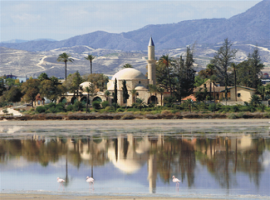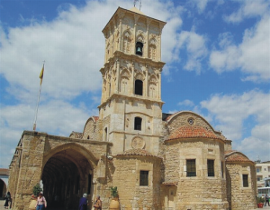About Cyprus
Cyprus is the third largest island in the Mediterranean. With a history over 10,000 years, the island has seen civilizations come and go and the likes of everyone from Alexander the Great to Cleopatra stake their claim here. Aphrodite made her home on Cyprus and travelers throughout antiquity came here just to pay her tribute.
Today Cyprus is a modern country that combines European culture with ancient enchantment. One of the benefits of being a Mediterranean island is the plentiful sunshine throughout the years. In fact, Cyprus epitomizes the ideal weather of the region with sunny days and fine temperatures almost every day. Extremes of temperatures are rare, meaning Cyprus has something to offer every month of the year, whether it's swimming (as late as November) or enjoying cultural sites and festivals (all year long).
Despite its small size, Cyprus has been at the crossroads of history for millennia. The island's strategic location has been a major factor in shaping its history throughout the centuries and, in recent years, its development into a centre for international business. World academic and scientific associations and organisations find that its location is no less strategic today - add to that, its unique combination of world class hotels, resorts and Mediterranean charm you have the perfect setting for holding productive meetings and conferences in a relaxed environment.
Four large cities punctuate the island, with Nicosia, the capital in the centre, and Larnaca, Limassol and Paphos along the southern coast. They are busy modern commercial and business centres, with old town centres with picturesque historical buildings, where you can wander along narrow streets and browse through interesting markets and shopping centres.
Larnaca City
Larnaca is a major city and one of the six districts in the Republic of Cyprus, which has continuous and uninterrupted history extending for 4000 years. In ancient times, the city and the whole of Cyprus was referred to as Kition, or (in Latin) Citium.
The city is located on the southern coast of Cyprus. It has a population of around 75,000 (2001) and it is the third largest city of Cyprus in terms of population.
Larnaca holds a major international airport and the island's second most important commercial port. It has a nice marina for yachts and is an important tourist resort. Larnaca International Airport is situated to the south of the city and island's oil refinery is to the north of the city.
Hala Sultan Tekk e Mosque of Umm Haram is one of the most important moslem pilgrimages in the world, ranking immediately after the shrines of Mecca, Medina and al Aksha in Jerusalem. Just by the Tekke Mosque you can view Larnaca salt lake. The lake is a natural sanctuary for all kinds of migrating birds including the endangered pink flamingos during springtime.
e Mosque of Umm Haram is one of the most important moslem pilgrimages in the world, ranking immediately after the shrines of Mecca, Medina and al Aksha in Jerusalem. Just by the Tekke Mosque you can view Larnaca salt lake. The lake is a natural sanctuary for all kinds of migrating birds including the endangered pink flamingos during springtime.

Church of Saint Lazarus is a magnificent Orthodox Church in Larnaca which was built in the town over the tomb of St. Lazarus, the brother of Mary and Martha.
The Phinikoudes (Palm Trees) promenade is Larnaca's main tourist attraction. An array of elegant restaurant-bars and cafeterias with fine international cuisine lay along the palm line. During the stroll towards the marine, you will pass by Larnaca Municipal Centre at Europe Square and see the bust of Kimon. At the end of the palm line you will also be able to visit Larnaca castle.
Larnaca is famous for its beautiful sea front. The city has an efficient tourist infrastructure, so you may enjoy the clean sandy beaches with clear blue waters and make a holiday to remember.
Interesting Links:
The Cyprus Tourism Organization's guidbook "Cyprus. 10000 years of history & civilisation" can be downloaded from here.